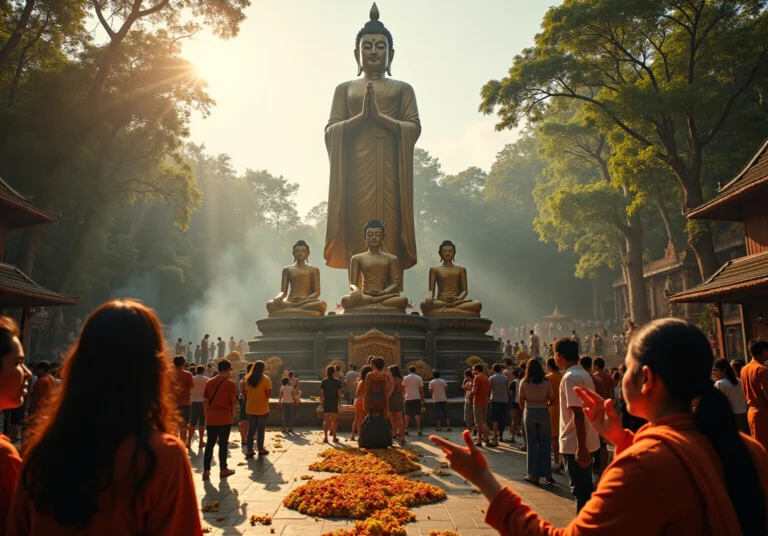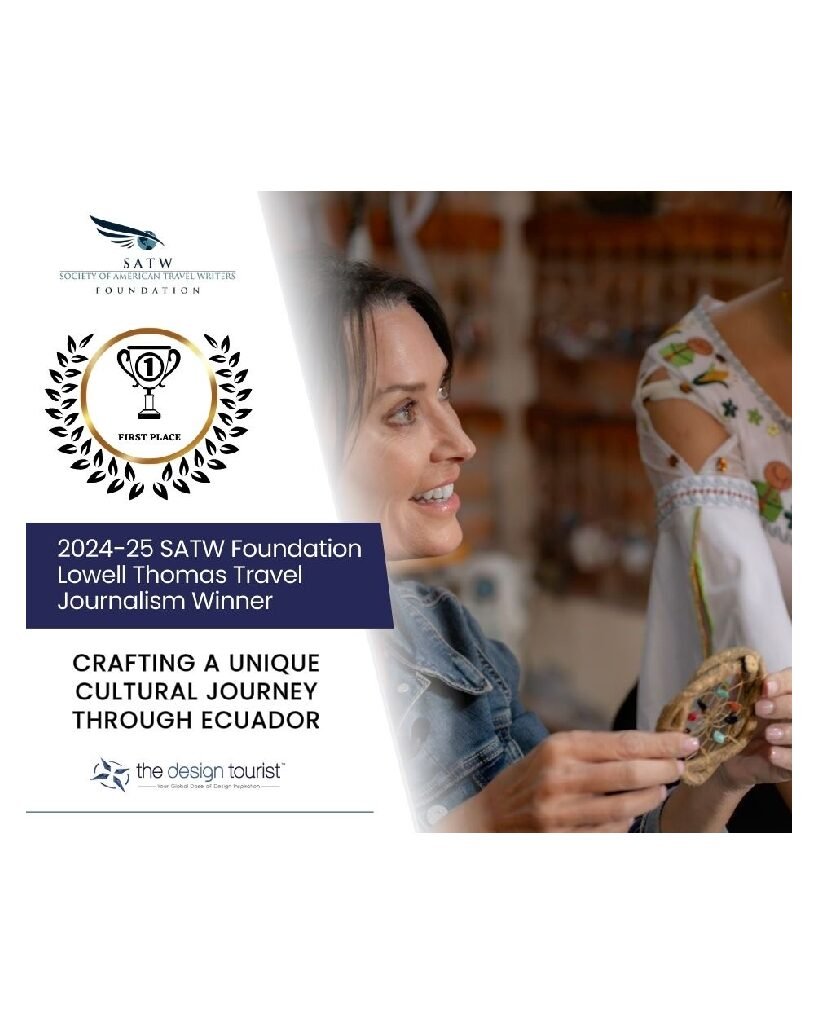Overview
Have you ever heard of the Four-Faced Buddha? Known as Phra Phrom in Thailand and Brahma in Hinduism, this fascinating figure holds a wealth of historical and cultural significance! It symbolizes omnipresence, wisdom, and interconnectedness—pretty intriguing, right?
Let’s dive into its origins, which trace back to ancient Hindu texts. You’ll find that this deity isn’t just a figure in a book; it has a vibrant presence in Thai culture, especially at the Erawan Shrine. Imagine witnessing the blend of Hindu and Buddhist practices during art displays, festivals, and community rituals across Southeast Asia! Each experience is a testament to the rich tapestry of cultures coming together.
So, whether you’re planning a trip or simply curious about this unique symbol, there’s so much to discover. I can’t wait for you to explore the captivating stories and traditions that surround the Four-Faced Buddha!
Key Highlights:
- The Four-Faced Buddha, known as Phra Phrom in Thailand and Brahma in Hinduism, symbolises omnipresence and wisdom.
- Each face of the Buddha represents a cardinal direction, emphasising interconnectedness and balance.
- The deity is associated with gifts of wealth, safety, and direction, making it a respected figure among followers.
- The origins of the Four-Faced Buddha trace back to ancient Hindu texts, with Brahma as the creator god.
- The Erawan Shrine in Bangkok, commissioned by King Rama I, is a significant site for worshippers and tourists.
- The cultural significance of the Four-Faced Buddha is evident in art, festivals, and modern architecture across Southeast Asia.
- Rituals include offerings of flowers, incense, and food, with acts of kindness performed to make merit.
- Festivals and ceremonies attract large crowds, enhancing community spirit and spiritual connexions.
Introduction
Have you ever heard of the Four-Faced Buddha? Known as Phra Phrom in Thailand and Brahma in Hinduism, this captivating figure stands as a symbol of creation and wisdom. With its four distinct faces, it embodies the interconnectedness of life, making it a fascinating topic to explore!
This multifaceted deity not only represents the cardinal directions but also offers profound insights into the rich tapestry of cultural and spiritual traditions across Southeast Asia. As you dive deeper into the history and significance of the Four-Faced Buddha, you might find yourself asking:
- How did this figure evolve from ancient Hindu texts to become a revered presence in Buddhist practices?
- What do its rituals reveal about the communities that honor it?
Let’s uncover these intriguing questions together!
Define the Four-Faced Buddha: An Overview
Have you ever heard of the Four-Sided Deity? Known as Phra Phrom in Thailand and Brahma in Hinduism, the four-faced Buddha holds a special place in both Buddhist and Hindu traditions. Imagine a four-faced Buddha, a deity depicted with four faces, each representing a unique aspect of creation and wisdom! The four-faced Buddha symbolizes the cardinal directions, embodying the idea of omnipresence and the ability to see in all directions. It’s a beautiful reminder of how interconnected we all are and the importance of balance in our lives.
You might be intrigued to learn that the four-faced Buddha is often linked to gifts of wealth, safety, and direction. This connection establishes it as a respected presence among its followers. So, next time you’re exploring these rich traditions, keep an eye out for this remarkable deity, and embrace the vibrant stories and meanings that surround it!
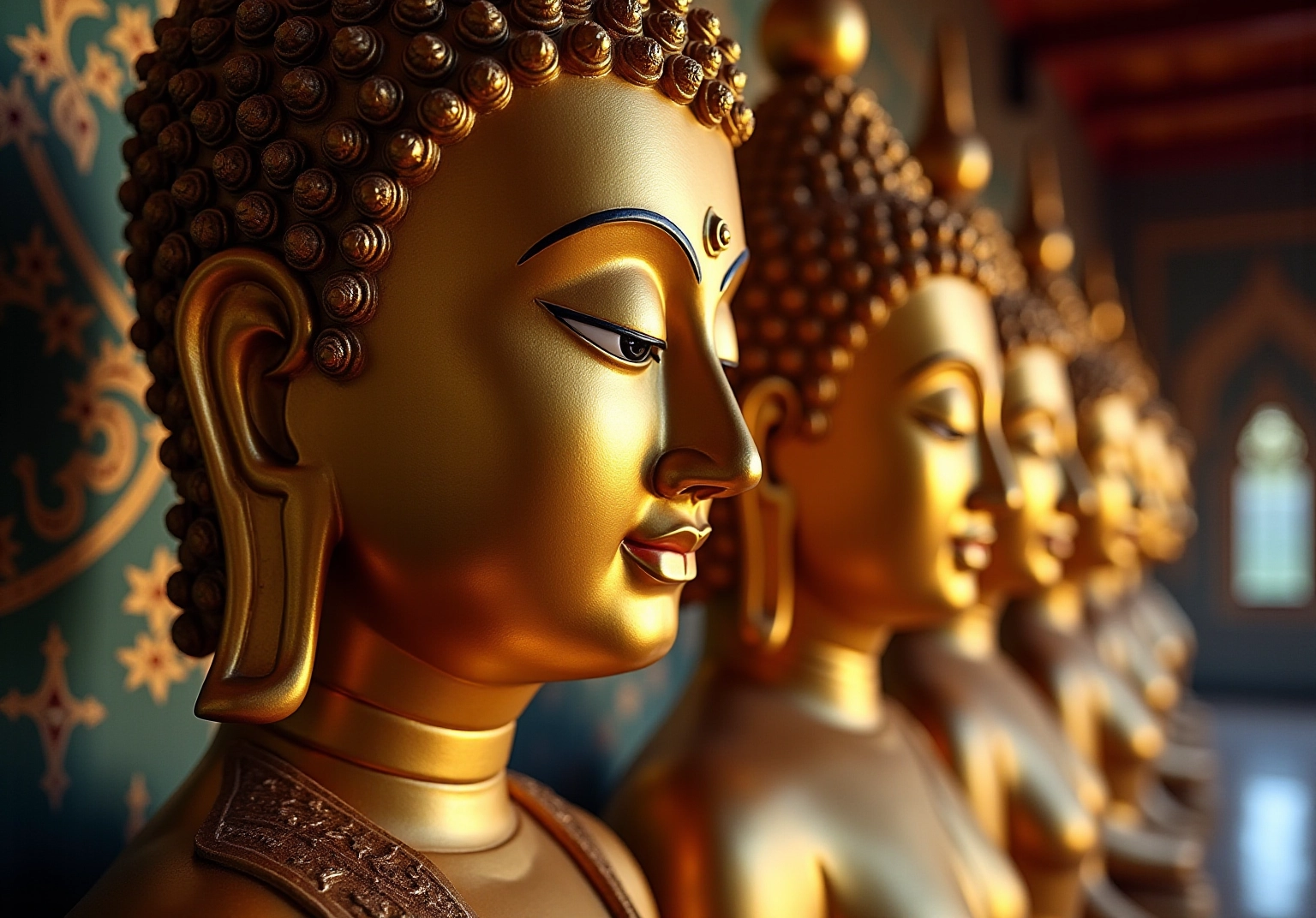
Trace the History of the Four-Faced Buddha
Did you know that the origins of the Quadruple-Faced Deity can be traced back to ancient Hindu texts? Brahma, the creator god, plays a central role in this fascinating story! As Buddhism spread across Asia, the image of Brahma found its way into Buddhist art, resulting in the emergence of the four-faced buddha in various cultures.
In Thailand, this enchanting four-faced buddha gained prominence during the reign of King Rama I. He commissioned the construction of the Erawan Shrine in Bangkok, which has since become a must-visit spot for worshippers and tourists alike! This shrine is now one of the most visited religious sites in the country, drawing people from all walks of life.
The historical journey of this multi-faced figure beautifully reflects the blending of Hindu and Buddhist beliefs. It’s a testament to how cultural exchanges can shape religious practices, creating a rich tapestry of traditions that you can explore when you visit these places. So, if you ever find yourself in Thailand, make sure to check out the Erawan Shrine and soak in the vibrant history and spirituality it offers!
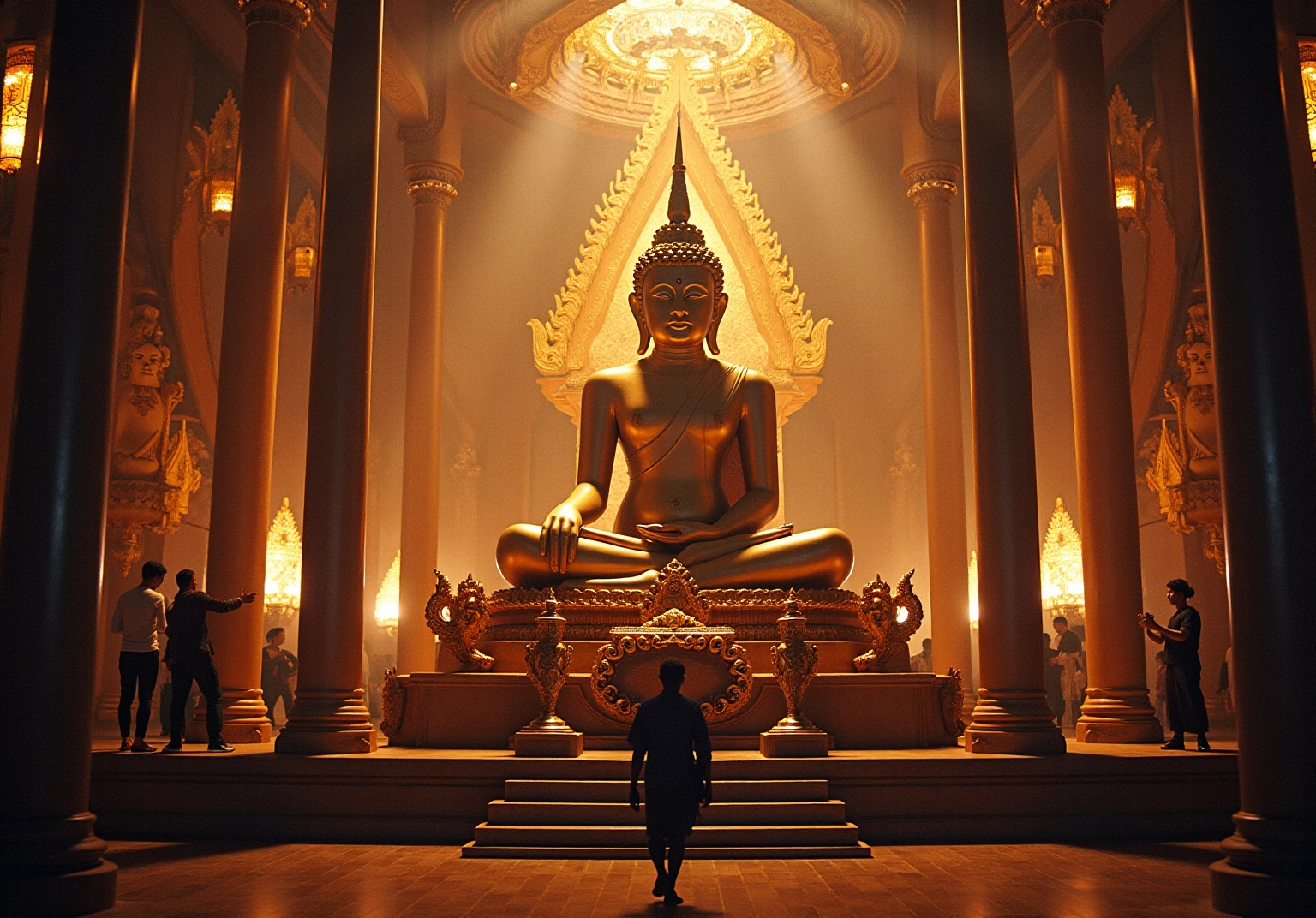
Explore the Cultural Significance of the Four-Faced Buddha
The four-faced buddha is a fascinating figure with deep cultural significance, especially in Southeast Asia! It’s often linked to prosperity and good fortune, drawing in worshippers who seek blessings for their success. You can really feel the deity’s presence in various forms of art—think intricate sculptures and vibrant murals—that showcase the local artistry and craftsmanship.
Festivals and rituals centered around the four-faced Buddha are a fantastic way to experience community spirit. Followers come together to offer prayers and perform traditional dances, creating a lively atmosphere filled with joy and connection. This cultural importance stretches beyond just spiritual traditions; it even influences modern design and architecture! You can see this in contemporary temples and public spaces that incorporate elements of the imagery associated with the four-faced Buddha, making it a truly enriching experience for anyone who visits.
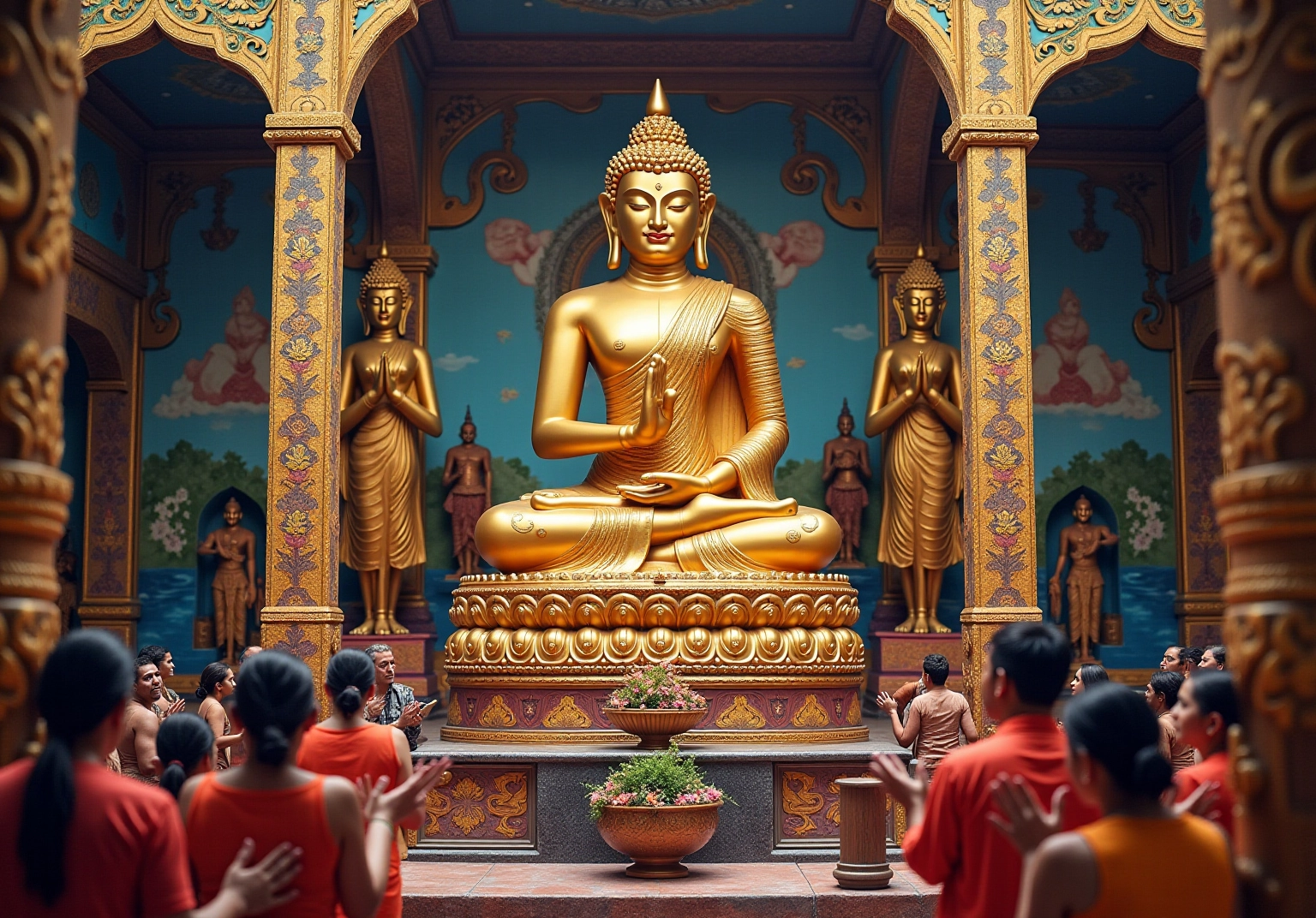
Understand Rituals and Practices Surrounding the Four-Faced Buddha
Rituals tied to the multi-faced Deity can vary by region, but they often include lovely gifts like blossoms, incense, and food, symbolizing reverence and dedication. In Thailand, for instance, the Erawan Shrine buzzes with activity! Here, worshippers engage in traditional dances and perform acts of kindness to make merit. You might even see people tying sacred threads around the statue—this is believed to bring protection and blessings.
During significant festivals, special ceremonies attract large crowds who come to seek guidance and express their gratitude. These vibrant rituals not only deepen the spiritual connection between devotees and the four-faced buddha but also strengthen community bonds. It’s a beautiful showcase of the enduring legacy of this revered figure, inviting you to experience the warmth and richness of these traditions firsthand!

Conclusion
The four-faced Buddha, known as Phra Phrom in Thailand and Brahma in Hinduism, is a fascinating figure that weaves a rich tapestry of history and cultural significance across borders. With its four distinct faces representing creation and wisdom, this deity stands as a powerful symbol of balance and interconnectedness. Isn’t it intriguing how its presence in both Buddhist and Hindu traditions highlights shared values and beliefs that resonate through different cultures?
As we delve into the origins of the four-faced Buddha, we can trace its journey from ancient Hindu texts to its prominent role in Thai culture, especially through the Erawan Shrine established during King Rama I’s reign. The blending of Hindu and Buddhist practices beautifully illustrates how cultural exchanges shape religious identities, fostering a sense of community and shared spirituality. And let’s not forget the vibrant rituals and celebrations surrounding the four-faced Buddha, which emphasize its importance in contemporary society. It’s amazing to see how traditional practices continue to thrive in our modern world!
Ultimately, the four-faced Buddha is a testament to the enduring legacy of spiritual beliefs and cultural heritage. Engaging with its history and significance invites you to appreciate the diverse expressions of faith and community that exist around the globe. Whether you find yourself visiting sacred sites, participating in lively festivals, or simply reflecting on its symbolism, embracing the essence of the four-faced Buddha can truly enrich your understanding of life’s interconnectedness and the pursuit of balance.
Frequently Asked Questions
What is the Four-Faced Buddha also known as?
The Four-Faced Buddha is known as Phra Phrom in Thailand and Brahma in Hinduism.
What does the Four-Faced Buddha represent?
The Four-Faced Buddha represents unique aspects of creation and wisdom, symbolizing the cardinal directions and the concept of omnipresence.
What are the key themes associated with the Four-Faced Buddha?
The key themes associated with the Four-Faced Buddha include interconnectedness, balance, and the gifts of wealth, safety, and direction.
Why is the Four-Faced Buddha respected among its followers?
The Four-Faced Buddha is respected among its followers due to its associations with wealth, safety, and guidance, making it a significant presence in both Buddhist and Hindu traditions.









